Part 2, a 1892 Hamilton (USA) with lever escapement, will be shared in the May 2025 issue.
My brother Ian and I have a small collection of antique pocket watches. Unlike wrist watches, especially by the big names, pocket watches can be acquired for more modest prices. The movements typically have good access in clip-on cases so can be admired unlike wrist watches unless a clear back.
Two examples will be shared as good examples of two different types of movement, the earlier verge this month and example of later lever escapements next month.
1813 Denton & Fox of Hull (UK) with verge escapement
We were keen to own an example of a watch with a verge escapement which predates the modern lever escapement The Wikipedia entry for the verge escapement describes it well including an animation. The entry notes that it was the earliest type of mechanical movement used first in clocks from the 13th century and through to pocket watches until the mid-19th century.
The power from the spring is transferred using a fusee chain. These are tiny linked chains akin to that on a bicycle. We first came across these when we owned a Joseph Casertelli microscope (reviewed by Ian) which used this type of chain to focus the condenser albeit in a crude manner and not successfully.
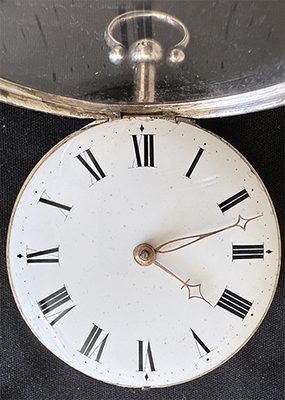
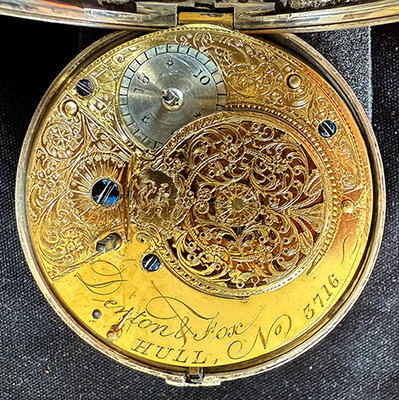
This Denton & Fox example caught our eye as the maker was based in Hull where we were born and brought up. This David Duggleby auction of a splendid ca. 1802 longcase clock notes they were working between 1779-1814 on Scale Lane and later Silver Street. These streets still exist in the old town. Many makers adorned their movements with very elaborate hand carved decorations on the upper brass plate as here. Given the movements would never normally be inspected by an owner it is indicative of the pride such makers took in their work. The ornate disc (below left) covers the balance wheel.
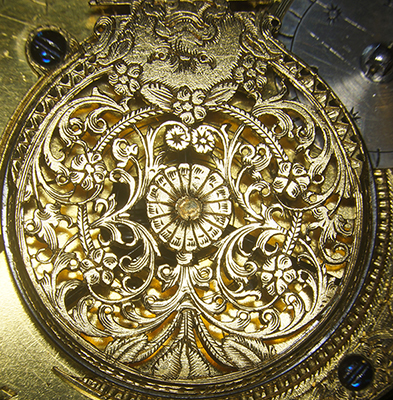
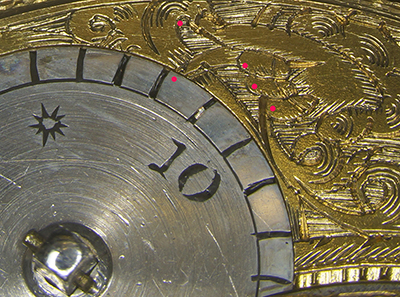
The user adjustment to the watch timekeeping is via the steel numbered dial using a square key (also used to adjust the watch hands). The position to set the wheel can sometimes be hard to see as the pointer can be very stylised. It is only when I inspected the plate under the stereo in the correct direction that recognised a hand with one finger pointing to the regulator wheel, the other three fingers curled up and thumb outstretched (outlined with red dots on image).

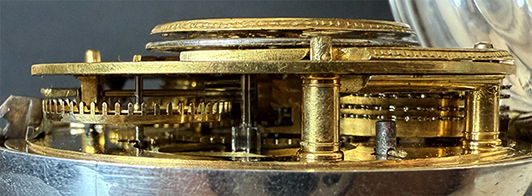
The side view of the movement (left above) shows the chain wrapped round the spring barrel on left and the fusee cone on the right, the latter is a stepped to even out the power delivered from the spring as it winds down. Wheels were typically handcut at this time as can be seen for the horizontal wheel (image right). The so-called verge cannot be seen, it is a vertical pin with two paddles at differing angles that transfer the movement to the drive wheels (see Wikipedia animation) via toothed escapement.
 The supports or balustrades separating the plates varied widely between makers in their ornamentation. They are simple pillars in this model but can be very intricate. The screws used are blued, controlled oxidation of the steel until adopted this colour. Many fittings are held down with pins, the sole use of
screws was adopted in later movements.
The supports or balustrades separating the plates varied widely between makers in their ornamentation. They are simple pillars in this model but can be very intricate. The screws used are blued, controlled oxidation of the steel until adopted this colour. Many fittings are held down with pins, the sole use of
screws was adopted in later movements.
The cases were invariably not made by the maker of the movement. The four hallmarks on the inside of the case (right) are as follows (with the help of one of the valuable resources online to identify British hallmarks).
Top, lion en passant - case of Sterling silver.
Left, leopard's head (often worn so hard to recognise) - London assay office.
Middle, 'IG' - case maker's mark. To date, of the number of makers using 'IG' have not found a maker that exactly matches this style of lettering.
Right, 'S' - date case made 1813. Letters were used repeatedly over centuries of hallmarking often in different font styles so helps to know the approximate era the watch was made to date correctly.
The watch still works reliably and has a very loud tick often to the point of being distracting in a room so only wound occasionally!